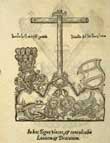Moses of Mardin
Moses von Mardin , also Moses Mardenus ( bl. 1548–1592), was a Syrian Orthodox clergyman. He got the first printing of the New Testament in Syrian language and script.
Moses was born in the village of Qaluq near Mardin as the son of the priest Ishaq and his wife Helene, later a monk and priest. From 1548 he is repeatedly in Europe, especially Rome , proven, where he was the envoy of the Patriarch of Antioch Ignatius XVI. ˁAbdallah (1521–1557) should strive for church union and the printing of Syrian books. In 1552 he made a Catholic creed in his and his own name. Since then he has been considered a Catholic ("ex Mesopotamia Catholicus sacerdos") in the West, although personally in faithfulness to the faith of his fathers. On March 15, 1556, he was allowed to use his own coat of arms in Vienna. For the first time during this time he was given the title of bishop in Europe , possibly wrongly throughout his life.
Moses was valued as one of the rare teachers of Syriac in Europe at the time. The first European syrologists Andreas Masius and Johann Widmannstetter were among his Roman students .
With and through Widmannstetter in Vienna from 1553 he found the necessary financial support (from King Ferdinand I ) for the first printed edition of the New Testament in Syriac and a Syrian grammar, which was published by Michael Zimmermann in Vienna in 1555 and 1556 respectively. The Syrian letters were cut by Kaspar Kraft after the elegant handwriting of Moses von Mardin. Two manuscripts in Syriac served as text templates, one that Moses von Mardin owned (today Cod. Vindob. Syr. 1) and one by Guillaume Postel . The two-volume NT edition is accompanied by a table of the biblical readings in the service in Syrian and Latin. Half of the edition (1000 copies) was brought by Moses on his return to the Orient, another part made it to the European market (dated 1562).
From 1556 Moses apparently worked again in the Orient, around 1560/61 in the Mār Ābay monastery, 1576/77 in Egypt, from 1578 again in Rome. There he was appointed professor of Syriac at the Collegio dei Neofiti in 1581 . He is mentioned for the last time in 1592.
A number of manuscripts have survived from Moses' hand, including a Latin missal in Syrian transliteration (Brit. Libr. Harley 5512; approx. 1550).
literature
- Andreas Müller: Symbolae Syriacae. Sive I. Epistolae duae Syriacae amoebaeae. Una Mosis Mardeni, Sacerdotis Syri; Altera Andreae Masii, JCti & Consil. olim Cliviaci. Cum Versione & Notis. Ut & II. Dissertationes duae de rebus itidem Syriacis, & è reliquis Mardeni Epistolis maximè . Berlin 1673.
- Johann Albrecht Widmannstetter: LinkKetābā d-ewangelyōn qaddīšā de-māran w-alāhan Yešuʿ mešiḥā. Reliqua hoc codice comprehensa pagina proxima indicabit… characteribus et lingua syra Jesu Christo vernacula… expressa. Liber sacrosancti Evangelii de Jesu Christo Domino et Deo nostro . Michael Cymbermannus excudebat (Michael Zimmermann), Vienna 1555.
- George Kiraz: The Widmanstadt-Moses of Mardin Editio Princeps of The Syriac Gospels of 1555 . Gorgias Press LLC, 2006, ISBN 1-59333-999-2 (facsimile with introduction)
- Robert J. Wilkinson: Orientalism, Aramaic and Kabbalah in the Catholic Reformation. The First Printing of the Syriac New Testament . Brill, Leiden 2007, ISBN 978-90-04-16250-1
- Sebastian Brock: The Development of Syriac Studies . In: The Edward Hincks Bicentenary . Ed. by Kevin J. Cathcart. Dublin 1994, 94-113.
- Grigory Kessel: Moses von Mardin (d. 1592) . In: Manuscript Cultures 9 (2016) 147-151 (on Moses' manuscript SUB HH, Cod. In scrin. 100 v. J. 1556).
- Pier Giorgio Borbone: “Monsignore Vescovo di Soria”, also Known as Moses of Mardin, Scribe and Book Collector . In: Christ. Vostok 8 (XIV), 2017, 79-114.
- András Mércz: The Coat of Arms of Moses of Mardin . In: Hugoye. Journal of Syriac Studies 22.2 (2019) 345-393.
Web links
Individual evidence
- ↑ Received in Latin translation: A. Masius: De paradiso commentarius, scriptus ante annos prope septingentos à Mose Bar-Cepha Syro (Antverpiae: Ex Officina Christophori Plantini, 1569) 257–262.
- ↑ On October 18, 1556, Moses was proven to have traveled to Syria through a book sale in Cyprus; see. Pier Giorgio Borbone: Introduzione . In: Le vie delle lettere: la Tipografia medicea tra Roma e l'Oriente , exhib.cat . Firenze (2012) 35.
| personal data | |
|---|---|
| SURNAME | Moses of Mardin |
| ALTERNATIVE NAMES | Moses Mardenus |
| BRIEF DESCRIPTION | Syrian Orthodox priest |
| DATE OF BIRTH | 16th Century |
| DATE OF DEATH | 16th Century |
